The Gift of South Dakota
Subscriptions to South Dakota Magazine make great gifts!
Subscribe today — 1 year (6 issues) is just $29!
A Sun Dance and Maka Waconi: Circle of Life
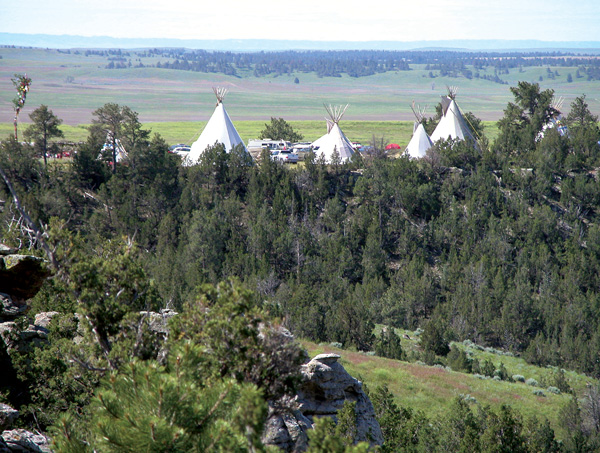 |
| A small village of tipis rises beyond the trees and boulders at the sacred Sun Dance site. |
Early on a sunny June afternoon I turn from Highway 71 onto a gravel road and enter the Black Hills Wild Horse Sanctuary south of Hot Springs. Within a mile, I see the hand-lettered “Sun Dance – Please Respect This Sacred Land.”
A dusty track leads higher into remote hills adorned with pine and cedar. Emerald green carpets the piedmont, and a warm breeze tugs at the brome, wild mustard and cheat grass. Patches of sweet clover bloom yellow and the air is thick with the piquant scent of sage.
In 1883, the U.S. government outlawed the Sun Dance, and Catholic and Episcopalian missionaries discouraged it. In his book The Lakota Way, Joseph M. Marshall III, wrote that the dance was characterized as “uncivilized and barbaric.”
They failed or chose not to see the ceremony for what it was: a symbolic act of sacrifice performed so that the people might live. Native Americans went underground with the Sun Dance until 1978, when the American Indian Religious Freedom Act legalized it.
Far back in the hills I pass a small herd of wild Sorraia Mustangs grazing beneath a stand of ponderosas on the sanctuary. Over another hill, the Cheyenne River runs high and muddy from recent rains. Along its bottom cottonwood leaves turn their silvery undersides to the breeze.
Passing through a livestock gate, I stop at another hand-lettered “Security” sign. Two Lakota men sit beneath a shade arbor next to a tipi. They welcome me, but also remind me that no recording devices or cameras are allowed.
It was one of many Sun Dances celebrated in summer on the Indian reservations of South Dakota, but the only one undertaken in the Black Hills. I was invited by Vic Glover, a former U.S. Army medic who flew helicopter medevac missions in Vietnam. A former journalist, he is author of the book Keeping Heart on Pine Ridge. A practitioner of traditional native spirituality, he is also a student of Buddhism and Christianity. Glover went to Asia several years ago as a volunteer after the huge Indian Ocean tsunami, and now lives much of the time in Thailand. He returns home each year to fulfill his pledge to take part in the Sun Dance.
I drive another half-mile to the dance site, where six poles fly American flags above MIA-POW flags. Just beyond, a forked cottonwood trunk stands 40 feet high in the center of a great circle. Colored cloth banners (red, green, blue, yellow) adorn its heights, flapping in the breeze. Other banners hang further down, as well as eagle feathers. Small “tobacco tie” prayer offerings to Tunkashila (God, the grandfather) wrap the entire trunk from top to bottom. Beyond, a fire pit heats rocks for sweat lodges bordering one side of the sacred dance site.
I park by other dusty cars and trucks and campers with license plates from Connecticut to California. Men and women nod or smile, though I am both a stranger walking into their most sacred ceremony and a wasicu (white guy). While some Sun Dances’ organizers do not allow non-native people to attend, others welcome people of different faiths and backgrounds. A third of the people at this Sun Dance appear to be non-native.
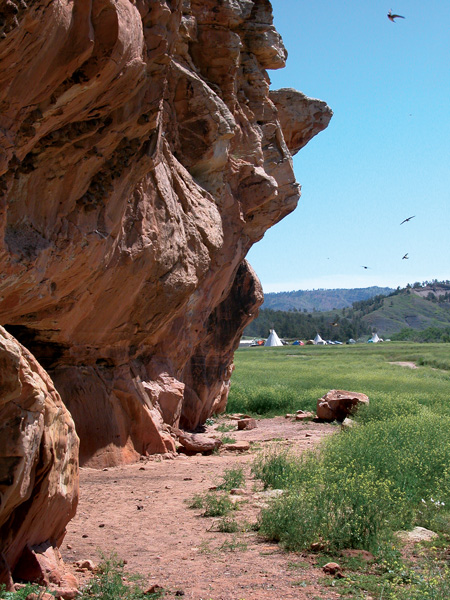 |
| Several Sun Dances are celebrated on South Dakota's Indian reservation every summer, but this was the only dance held in the Black Hills. |
Father William Stolzman, a Jesuit priest, spent years on the Rosebud Reservation. For six years he convened bi-weekly meetings with other priests and Lakota medicine men to discuss Christianity and traditional Lakota spirituality. His meetings resulted in his 1986 book The Pipe and Christ, which describes similarities and differences between Lakota, Dakota, and Nakota peoples’ traditional spiritual practices and Christian religious practices.
The book shows our shared humanity, but also the gulf between the ways two cultures see the world in general, and American popular culture in particular. At Stolzman’s meetings between priests and medicine men, the priests — curates of a religious culture full of complex doctrine and righteous certainty — spoke quickly and confidently and asked pointed questions of the medicine men.
The Lakotas were often upset by this bluntness of manners. Careful and slow to speak, they came to any topic indirectly, then spoke for longer periods. About some wakan (sacred) matters they were reluctant to speak at all, considering that disrespectful.
At the sun dance site, a huge circular dance area is marked off by a two-foot high fence of willow switches painted bright red around half of the circle, and bright blue around the other half. The base of each vertically arrayed willow switch has been buried and it forms one fragile stick of the fence that demarcates the sacred dance area. Near the top of each of the hundreds of willow switches that formed the circle, a small tobacco tie is knotted, alternating in the sacred colors of the four compass directions: red, yellow, black, white. They are offerings of tobacco to each of the 405 spirits that have something to do with humans.
Four openings in the great circle mark the four directions. Surrounding the entire circular site a vast brush arbor was constructed, consisting of forked pine tree trunks perhaps four inches in diameter. The base of each is now buried into the ground so that each trunk stands vertically. Lashed atop their forks, and crisscrossed in a rough lattice on top, tree limbs have been tied in place with cord or wire. Shaded beneath the arbor are some 50 spectators, plus three bands of drummers and singers who sit in circles around their drums.
Within the dance circle itself, perhaps 60 men and women in traditional Lakota garb dance in the day’s third of four dances. The men, naked from the waist up, are attired in ankle length wraps of red or blue cloth. Some carry eagle wing fans and their personal or family canupas (pipes made of traditional pipestone — “peace pipes” as we wasicus have called them).
Many men wear two standing eagle feathers attached within a thick cylinder of sage wrapped in spirals of red cloth and worn around their heads like a crown. Tufts of sage hang from the front over their brows. Sage cleanses a person’s body and spirit, and perhaps in wearing it this way the sage precedes the wearer on his path to cleanse him as he moves forward in the dance — just as in life.
Some male dancers bear healed scars in their chests and backs from past years’ piercings. Several others have fresh wounds from the morning’s dances, when some men were pierced with scalpels and lashed to the great tree by buffalo hide or plain manila ropes. One man has dabs of shredded tobacco stuck like a poultice to his still-raw wounds.
Beneath the brush arbor, I ask around and finally locate Vic Glover resting and talking with five other male dancers in one of the tipis. We’ve corresponded via e-mail for the last year, yet until today have never met face-to-face. He introduces me to each of the men and they greet me politely and bring me into their conversation.
After a time, I step outside as they prepare for the day’s fourth and last dance. The dance ensues, and at its conclusion all the young and old spectators, myself included, step outside the arbor’s shade. We stand side by side as the long line of dancers passes slowly. Each dancer looks into our eyes and acknowledges each of us, pausing to purify us with smoldering sage, or grace our shoulders and hands by a touch of their pipes, or stroke us all around with eagle wing fans.
Each dancer, whether pierced or un-pierced, is a person who pledged to dance long ago, then prepared a year or more for these four days of fasting and dancing. And now, after his or her exertions and personal sacrifice, each pointedly blesses each of us.
Then, one dancer looks at me as he touches his pipe and eagle wing to my shoulders, forehead and hips. He says firmly, “Take off your glasses. Don’t wear glasses while you’re being blessed.” I feel a rush of irritability, for no one in the long line of dancers that preceded him complained about my eyeglasses. In an instant, though, I make a decision to treat his words as education rather than insult; I remove my glasses and thank him. He nods and moves on to bless the next person. (Later, I learn that he serves as one of the Sun Dance’s overseers.)
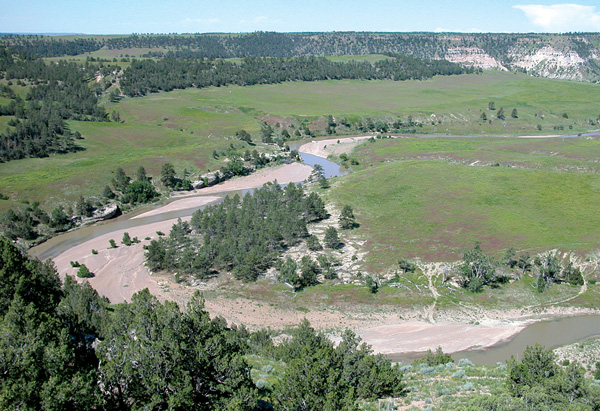 |
| The twisting Cheyenne River runs high and muddy, and the land beyond is a carpet of green from spring rains. |
Afterward, Glover invites me to eat at the main camp with the other spectators, though he and other dancers will remain in the tipis at the dance site for four days, fasting and praying and resting between dances. I drive down to the camp beside the Cheyenne River. On a beach in the river bend a sweat lodge has been erected and above it on the meadowed bench of matted grass is a small village of tents and tipis.
The sinking sun lingers, its light falling yellow-green on the small camp and the nearby sandstone cliffs. I walk to the cliffs and examine a wide wall of petroglyphs that have been scored into the sandstone over millennia. Beside this ancient artwork, listening to the children’s laughter in the tipi camp, I place my palm on the glyph of what looks like a mammoth, extinct now for thousands of years.
People continue to pull up in cars and pickups and vans from the dusty gravel track that leads about a mile from the hilltop Sun Dance site. Some crank up their Coleman stoves or campfires, though many converge on the cook tent and brush arbor where a group of women have been preparing food. Kids yell and play and rush around while the adults, from vigorous young to frail elders, laugh and greet one another with smiles and hugs.
Watching such camaraderie with its warm and cheery flavor of a homecoming of relatives — and as welcome as these folks have helped me feel — I still feel strangely shy and a bit overwhelmed so I start my car and steal away.
The next day, I arrive at the dance site in early afternoon, just before the beginning of the third dance. One young man from Glover’s tipi has two new wounds in his chest — the marks of selflessness and sacrifice.
This day’s third dance begins. Men and women dancers move into the circle to the drummers’ and singers’ song. The dance lasts a long time, and though finally the dancers stop, the drummers and singers continue, and one of the ceremony’s overseers brings a tanned buffalo hide to the great tree and unfolds it on the ground.
Now, another young man will be pierced, a fulfillment of his vow to willingly suffer so that his people might be relieved of their afflictions. Sun Dance sponsors and dance leaders Tom and Loretta Cook of Chadron, Neb., lay the volunteer dancer down on the buffalo hide with the help of two other dancers. One of the assistants is the former Army medic, Vic Glover.
We watch from the shade beneath the brush arbor as Tom Cook pierces the man’s chest with a scalpel and inserts bone or hardwood skewers on left and right above his nipples, then ties buffalo hide ropes to the awls. Finally, Glover and Cook help the man to his feet and he begins to dance. The far end of the long rope is looped over a cross bar high on the tree, and two other male dancers take up that end of the rope.
The high cross bar becomes a rough pulley, so that when the men who hold the rope dance away from the tree the rope becomes taut and pulls the pierced dancer’s muscles so tight that they are drawn out from his chest, a great agony. Blood streams down his belly as, arms spread wide, he waves his two eagle wing fans and looks toward the sky and sun, beseeching Tunkashila and praying for his people.
The two dancers opposite the circle pull their rope harder and the man lifts into the air, spinning, hanging by the bone skewers hooked through his chest muscles until finally, from the weight of his suspended body, the two skewers rip through his chest muscles and come free. He spins to the ground where the assistants instantly provide support. For long seconds the man stands, resting shakily with their help.
Gathering himself, he raises his eagle wing fans, spreads his arms and dances around the circle. Cook and Glover go along to attend him, glancing repeatedly at his face as he progresses. As he arrives at each of the four openings in the circle, the pierced dancer turns and raises his arms toward God and the sun.
When the three men finally stop by the great tree, other dancers and members of the dancer’s family approach him, placing hands on him in gratitude and praying for him and for the community. His torn muscles still extend an inch or more through the two holes in his chest, though gradually they will withdraw back within his twin wounds.
In The Pipe and Christ Stotzman wrote, “Some people have great difficulty understanding and appreciating the tearing of flesh that takes place in the Sun Dance. Many cannot understand that there are higher values for which health is to be sacrificed. Modern Christians generally have little appreciation for the early Christian’s eagerness and joy in material penances, persecution, and martyrdom.”
Stolzman interviewed young men who had been pierced and tethered in the Sun Dance. Some told him that they identified “with Christ, asking Him for strength… They gave themselves completely, body and soul, to God in ways they had never done before. They recognized their failings and their weaknesses … their limitations and their strengths. They discovered the love they had for their God and their people.”
The hilltop ceremony will last two more days, but in late afternoon I leave for home. At a rocky promontory nearby, I pull off the dusty track, shut off my car’s engine and step outside. My eyes drift down the bouldered scarp to the distant river bottom where, far below, seven huge white pelicans slowly flap along the winding Cheyenne, casting dark shadows on its muddy waters. Beyond, the rim rock mesas glow red and tan and the firmament above shimmers cobalt blue. Far to the north, evening thunderheads are blooming above the Black Hills.
Editor’s Note: This story is revised from the November/December 2008 issue of South Dakota Magazine. To order a copy or to subscribe, call (800) 456-5117.


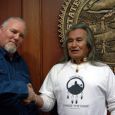
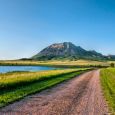
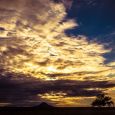
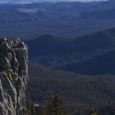
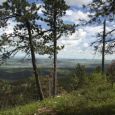
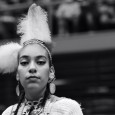


Comments
Warm Regards,
Gloria
I was involved for three years with the sun dance at kyle SD.
When verenel cross was still with us back in 1994-1997. I am trying very hard to find an old friend. He is a nephew to him, his name is Blue Cross.
I Don know we're to turn and was wondering how to contact him.
Please any help at this point would be greatly appreciated.
Thank you
Tony Benton
Daphne
If anyone can provide information that would be greatly appreciated.
Thank you
Especially if the body is seen in Native culture as "the temple of the Spirit," making an effort to wound it seems to be a major philosophical paradox.
She started as a drummer then started dancing 3 summers ago. We were there in 2018 as observers when she was a drummer. It is a beautiful, spiritual ceremony. I see the waloot ( tree they dance around ) as their altar. The piercings, while difficult to watch, reminds me of the suffering Christ soent on the cross
I had a dream of having to go to dance with the Lakota 4 years ago.
I still haven't managed to do so, as I'm in Germany and don't have any clue of how to get there or where to go. i don't have a connection, but I feel a calling of getting in touch and learning more.
I've been to quite a few sweat lodge ceremonies being held in Europe in the past 6 years and have a lot of respect towards the ancient rituals. At the same time I feel a connection that I dont fully understand yet.
Does anybody have a hint for me? It feels to ke that it's not as simple as just going there. I'd be happy about any help:)
Love, Isa